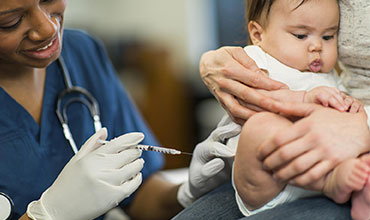Factors Influencing the Participation of Mothers of Mothers in the Expanded Programme on Immunization, in the Nkoranza South Municipality, Ghana

Abstract:
The WHO, in 1974, proposed and launched the Expanded Programme
on Immunization to immunize children against 6 childhood killer and other diseases,
aimed at achieving and maintaining more than 90% coverage with all the vaccines.
However this has not been achieved.
The purpose of the study was to determine the factors influencing
the participation of mothers of mothers in the Expanded Programme on Immunization,
in the Nkoranza South Municipality.
Study Population: The study population comprised of mothers with children
less than five years who are attendants at St. Theresa’s Hospital, Nkoranza Municipality. Study Design: A descriptive
study with cross-sectional design was carried out to evaluate knowledge of mothers’
on the importance It was conducted over a six weeks period. Sampling Method: Purposive
sampling was used to select 150 respondents for this study. It enabled the selection
of unique cases in which the result may or could be extended to the whole population.
The units or respondents were intentionally picked for the study because of their
characteristics or qualities which are not randomly distributed among the general
population but they exhibit most of the characteristics of interest of the study.
Sample Size: A sample size of 150 was chosen out of convenience from
the municipality. It comprised of mothers of children less than five years. Data Collection: A questionnaire comprising
both closed and open ended questions were administered to respondents. The questionnaire
was pre-tested on randomly selected mothers awaiting consultation in the OPD. Both
English and Twi languages were used in the administration of the questionnaire. Data Analysis: The
data gathered was analyzed both manually and using Microsoft Excel and the results
were expressed in percentages using charts and tables. The
results obtained showed that the most popular reason for defaulting was that the
mother travelled at the time the child was to be immunized (36.36%). This shows
absence of knowledge that in so far as the mother is in possession of the child’s
Road To Health Chart, the child will be immunized. The
results also revealed that most of the mothers had heard about immunization (98%)
and believed it cured disease (42.6%). The smaller proportion who knew it prevented
disease (24.7%), were knowledgeable about the diseases it prevented. Just over half
the children in the study were fully immunized (55.3%) and almost a quarter of the
children had either defaulted or never been immunized. Presence of side effects,
The mothers who said their children experienced
side effects were asked to specify what kind of side effects the children had. Over
half the mothers (56.25%) complained of fever, 35.4% of the mothers complained that
the vaccination site got swollen. Other mothers with complaints (8.3%) complained
of things like excessive crying and other non specific symptoms. This study revealed that the
more than half (55.3%) of the children were fully immunized. the proportion of those
who had not been fully immunized (22%) and those whose immunization was up to date
(21.3%) was about the same. the lowest percentage was recorded for those who had
received no vaccinations at all (1.3%). The
main conclusions drawn The most common reason was that
the mother travelled long distance (36.36%) at the time the child was due to receive
the next vaccination and did not take the child when she returned because the time
had passed. the next reason was that the child was ill (15.15%) at the time he/she
was supposed to receive the vaccination and was not taken to the immunization centre
upon recovery. the ill child tied with mother being too busy with work (15.15%)
to take the child to the immunization point. also tying, were the mother being ill,
so she was unable to take the child and postponing the immunizations for social
functions etcetera with 12.12%. and also that mothers
did not have sufficient knowledge about vaccine preventable diseases, also a little
than half of the people surveyed had fully immunized their children.
Keywords: Distance travel, sufficient knowledge, cure disease, defaulted
immunization, bibliographic data, and side effects.
References:
[1]. Dodoo, A. N. O., Renner,
L., van Grootheest, A. C., Labadie, J., Antwi-Agyei, K. O., Hayibor, S et.al (October,
2007). Safety monitoring of a new pentavalent
vaccine in the expanded programme on immunization in Ghana. Drug Safety, 30(4),
16/01/08-347-356 (10).
[2]. El-Shazly, M. K., Farghaly, N. F., AbouKhatwa,
S. A., & Ibrahim, A. G. (1991). Comparative
study of mothers' knowledge of children immunization before and after mass media.
Journal of the Egyptian Public Health Association, 66(5-6), January 2008-609-24.
[3]. Gust, D. A., Kennedy, A., Wolfe, S., Sheedy,
K., Nguyen, C., &Campbell, S. (2008). Developing
tailored immunization materials for concerned mothers. Oxford Journals, Health
Education Research Volume, 23(3), January 2008-499-511.
[4]. Isomura, S., Ahmed, A., Dure-Samin, A.,
Mubina, A., &Takasu, T. (1992). Epidemiological
studies on measles in karachi, Pakistan-mothers' knowledge, attitude and beliefs
about measles and measles vaccine. Pediatrics International, 34(3), 290-294.
[5]. Manjunath, U., & Pareek, R. P. (2003). Maternal knowledge and perceptions about
the routine immunization programme--a study in a semi-urban area in Rajasthan. Indian Journal of Medical Sciences,
57(4), 158-158-163.
[6]. Schoub, B. D., Johnson, S., McAnerney,
J. M., Blackburn, N., Kew, M. C., McCutcheon, J. P., (1991). Integration of hepatitis B vaccination into
rural African primary health care programmes. British Medical Journal, 302(6772),
313-316.
[7]. Shimp, L., & Kagondu, G. (2005). Integrating and supporting expanded program
on immunization (EPI) communication. The Communication Initiative website: The
Communication Initiative.
[8]. U.S. Department of Health and Human Services
(2008) Healthy people. Retrieved 11/02, 2008, from www.healthypeople.gov
[9]. World Health Organization. (1989).World
health assembly resolutions. The Forty-Second World Health Assembly, 1.12.1.
[10]. World Health Organization (2008). Immunization surveillance, assessment and monitoring. Retrieved 01/2008, 2008, from
http://www.who.int/immunization_monitoring/en/
[11]. World Health Organization, & Expanded Programme on Immunization. (1985). EPI: A global overview.69 (72), 17-89-104.
[12]. Information & Knowledge for Optimal Health (INFO) Project. (2008). Retrieved 11/02, 2008, from www.popline.org

